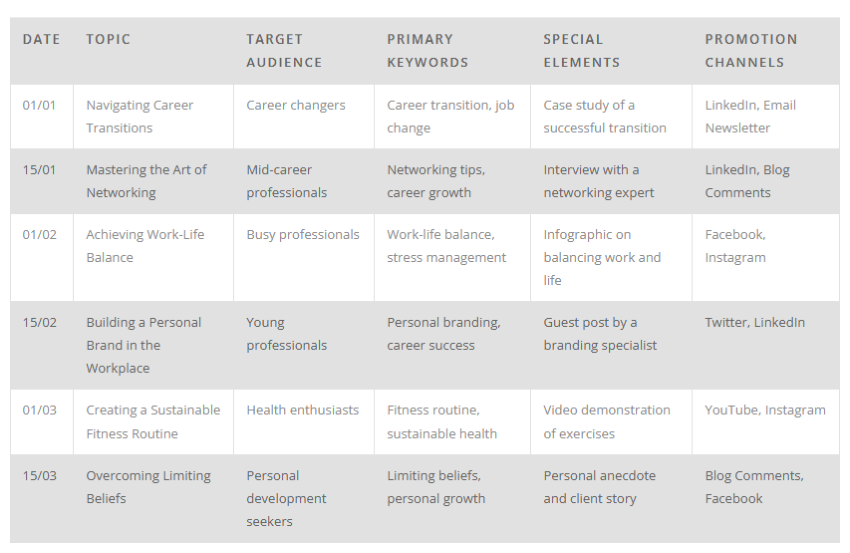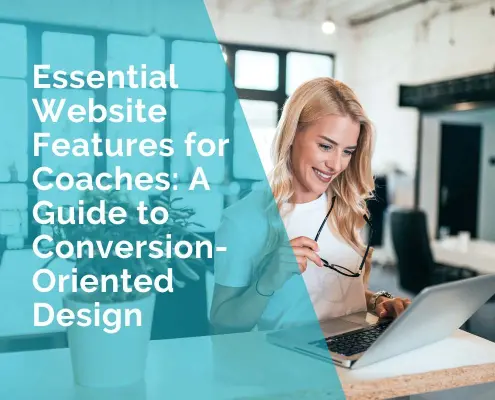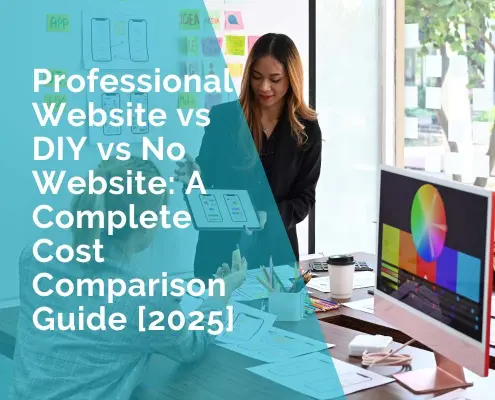Struggling to Attract Clients? Transform Your Coaching Website Content
Are you finding it difficult to turn website visitors into paying clients? You’re not alone. Many coaches face this challenge, but the solution might be simpler than you think. By transforming your website content, you can better engage your audience and highlight the unique value you offer.
This guide will help you revamp your content strategy, focusing on clear messaging, engaging visuals, and strategic content placement. With these changes, your coaching website can become a powerful tool for attracting and converting clients.
1. Identifying the Problem
Understanding why your coaching website isn’t attracting clients is the first step towards transformation. Often, the issue lies in unclear messaging or content that doesn’t resonate with your audience. It’s crucial to identify the specific needs and pain points of your target clients—whether they’re seeking personal growth, business strategies, or lifestyle changes.
By aligning your content with these needs, you can create a more compelling and relevant experience for your visitors. Consider conducting surveys or interviews with current clients to gain insights into what initially drew them to your services. This information will be invaluable as you refine your website content to better meet the expectations of potential clients.
2. Crafting a Compelling Home Page
Your homepage serves as the digital front door to your coaching business. It’s where potential clients form their first impressions, so it’s essential to make it both inviting and informative.
A well-crafted homepage can effectively communicate your unique value proposition and guide visitors toward taking action.
Actionable Steps:
Value Proposition
Your value proposition should succinctly convey the unique benefits your coaching offers. Here are detailed examples for different types of coaching businesses:
Life Coaching: “Empower your journey to personal fulfillment and unlock your true potential with tailored strategies and empathetic guidance.”
Business Coaching: “Transform your business strategies with expert insights and actionable plans to achieve sustainable growth and success.”
Health Coaching: “Achieve your wellness goals through personalized coaching that integrates holistic health practices and evidence-based strategies.”
Career Coaching: “Navigate your career path with confidence and clarity, leveraging personalized coaching to reach your professional aspirations.”
Engaging Visuals
Use high-quality, authentic images that reflect your coaching style and resonate with your target audience. Consider including:
Professional photos of yourself to build a personal connection.
Images of clients (with permission) or stock photos that represent your coaching niche.
Visuals that convey the transformation or outcomes your clients can expect.
Clear Navigation
Ensure your homepage has intuitive navigation that guides visitors to key sections, such as your About Page, Services, and Contact Information.
Testimonials and Social Proof
Feature client testimonials or success stories prominently on your homepage. This builds credibility and demonstrates the real-world impact of your coaching.
Call to Action
Include a strong, action-oriented call to action. For example, “Ready to transform your life? Book your free 30-minute consultation today.” Ensure this links directly to your Calendly for easy scheduling.
Consider your homepage as the foyer of a prestigious office building. It should be welcoming, informative, and reflective of the professionalism and expertise you offer. Just as a well-designed foyer sets the tone for the rest of the building, your homepage should guide visitors seamlessly to the next step in their journey with you.
3. Building Trust with an Authentic About Page
Your About Page is more than just a biography—it’s an opportunity to build trust and connect with potential clients on a personal level. This page should convey your expertise, values, and the unique journey that led you to become a coach.
Actionable Steps:
Share Your Story
Begin with a compelling narrative that outlines your journey into coaching. Highlight key experiences and milestones that have shaped your approach. For example, “After a decade in corporate leadership, I discovered my passion for helping others unlock their potential, leading me to a fulfilling career in life coaching.”
Highlight Your Expertise
Clearly outline your qualifications, certifications, and any relevant experience that establishes your credibility. Use bullet points or a brief paragraph to make this information easily digestible.
Connect with Personal Anecdotes
Use personal stories or anecdotes to illustrate your coaching philosophy and approach. This helps potential clients relate to you on a human level. For instance, “I once worked with a client who felt stuck in their career. Through our sessions, we uncovered their true passion, leading to a successful career transition.”
Include Testimonials
Feature a few select testimonials that speak to your character and effectiveness as a coach. This social proof can reinforce the trust you’re building.
Call to Action
Encourage visitors to take the next step, such as scheduling a consultation or exploring your services. For example, “Curious about how I can help you achieve your goals? Book your free 30-minute consultation today.”
By crafting an authentic and engaging About Page, you can establish a strong connection with potential clients, making them more likely to trust and choose your services.
4. Showcasing Your Services
Your Services Page is where potential clients learn about the specific coaching packages and solutions you offer. It’s crucial to present this information clearly and persuasively to help visitors understand the value of your services.
Actionable Steps
Clear Descriptions
Provide detailed descriptions of each coaching package or service you offer. Highlight the benefits and outcomes clients can expect. For example, “Our Business Growth Package includes personalized strategy sessions designed to boost your company’s performance and profitability.”
Structured Layout
Use a structured layout with headings and bullet points to make information easy to scan. Consider organizing services by category or client need.
Pricing Information
If appropriate, include pricing details or a range to set clear expectations. Transparency can build trust and help potential clients make informed decisions.
Visual Elements
Incorporate visuals such as icons or infographics to illustrate key features or benefits of your services. This can make the page more engaging and easier to understand.
Internal Links
Link to relevant pages, such as your Portfolio Showcase for examples of past work or success stories.
Call to Action
Encourage visitors to explore your services further or download a resource. For example, “Discover how our tailored coaching solutions can transform your journey. Download our free guide to learn more about the benefits of our services.”
By clearly showcasing your services and the value they provide, you can help potential clients understand how you can meet their needs and encourage them to engage with your offerings.

Make Your Website Work for You!
Book your free strategy session with me today and discover how tailored web design can transform your client engagement.
5. Leveraging Testimonials and Success Stories
Testimonials and success stories are powerful tools for building credibility and trust with potential clients. They provide social proof that your coaching services deliver real, tangible results.
Actionable Steps:
Select Impactful Testimonials: Choose testimonials that highlight specific outcomes or transformations your clients have experienced. For example, “Working with [Your Name] helped me increase my business revenue by 30% in just six months.”
Diverse Client Experiences
Showcase a range of testimonials that reflect the diversity of your client base and the various challenges you’ve helped them overcome. This can include different types of coaching, such as life, business, or health coaching.
Success Stories
Share detailed success stories that outline a client’s journey from start to finish. Include the challenges they faced, the strategies you implemented, and the results achieved. This narrative approach can be more engaging and relatable.
Visual Elements
Use photos (with permission) or video testimonials to add authenticity and a personal touch. Visual testimonials can be more engaging and help potential clients connect with the experiences of others.
Internal Links
Link to your Portfolio Showcase for additional examples of your work and client success stories.
Call to Action
Encourage visitors to envision their own success by engaging with your services. For example, “Ready to start your success story? Learn more about our coaching solutions and see how we can help you achieve your goals.”
Your website is your first handshake with potential clients. Make it count by ensuring every piece of content speaks to their needs and aspirations.
Ivana Katz
6. Optimising for SEO
Search Engine Optimisation (SEO) is crucial for increasing your website’s visibility and attracting more potential clients. By implementing basic SEO strategies, you can ensure your coaching website ranks higher in search engine results, making it easier for people to find you.
Actionable Steps:
Keyword Research
Identify relevant keywords that your target audience is likely to search for. Use these keywords naturally throughout your content, including in headlines, subheadings, and body text.
On-Page SEO
Ensure each page has a unique title tag and meta description that includes your target keywords. This helps search engines understand the content of your pages and improves click-through rates.
Internal Linking
Use internal links to guide visitors to other relevant pages on your site, such as your Service Page or Portfolio Showcase. This not only improves navigation but also helps search engines crawl your site more effectively.
Optimise Images
Use descriptive file names and alt text for all images on your site. This improves accessibility and helps search engines index your images.
Mobile Responsiveness
Ensure your website is mobile-friendly, as search engines prioritize mobile-optimized sites in their rankings.
External Links
Link to authoritative sources where relevant to provide additional value to your readers and enhance your site’s credibility.
By optimising your website for SEO, you can increase its visibility, attract more visitors, and ultimately convert more of them into clients.
7. Engaging Blog Content
Maintaining a blog on your coaching website is a powerful way to attract and engage potential clients. It allows you to showcase your expertise, provide valuable insights, and build a community around your coaching philosophy. Here’s how to make your blog content engaging and effective:
Actionable Steps
Identify Relevant Topics
Choosing the right topics for your blog is crucial to attracting and engaging your target audience. To ensure your content resonates with potential clients, consider the following strategies:
-
Understand Your Audience’s Needs: Start by identifying the common challenges and goals of your target audience. For example, if you’re a career coach, your clients might be interested in topics like career advancement, job search strategies, or work-life balance.
-
Conduct Audience Research: Use surveys, interviews, or social media polls to gather insights directly from your audience. Ask them what topics they find most valuable or what challenges they’re currently facing.
-
Analyze Competitor Content: Look at what topics other coaches in your niche are covering. Identify gaps or areas where you can offer a unique perspective or deeper insights.
-
Leverage Keyword Research: Use tools like Google Keyword Planner or SEMrush to find popular search terms related to your coaching niche. This can help you identify topics that have a high search volume and are relevant to your audience.
-
Stay Updated with Industry Trends: Keep an eye on the latest trends and developments in your coaching field. Writing about current topics can position you as a thought leader and attract readers interested in the latest insights.
-
Create Evergreen Content: Focus on topics that remain relevant over time, such as foundational skills or strategies. For example, a life coach might write about “Developing Resilience in Challenging Times,” a topic that is always pertinent.
-
Use Client Questions as Inspiration: Pay attention to the questions your clients frequently ask during sessions. These can be excellent topics for blog posts, as they address real concerns and provide valuable information.
Examples for Different Coaching Niches:
-
Career Coaching:
- “Navigating Career Transitions: Tips for a Smooth Change”
- “Building a Personal Brand in the Workplace”
- “Mastering the Art of Networking for Career Success”
-
Life Coaching:
- “Achieving Work-Life Balance: Strategies for Busy Professionals”
- “Overcoming Limiting Beliefs to Unlock Your Potential”
- “Mindfulness Practices for Everyday Life”
-
Health Coaching:
- “Creating a Sustainable Fitness Routine”
- “Nutrition Tips for a Balanced Diet”
- “Stress Management Techniques for a Healthier Lifestyle”
Create a Content Calendar
A content calendar is an essential tool for planning and organizing your blog posts. It helps you maintain consistency, ensures a diverse range of topics, and aligns your content with your business goals. Here’s how to create and utilize a content calendar effectively:
-
Define Your Goals: Start by identifying what you want to achieve with your blog. Are you aiming to increase website traffic, establish authority in your niche, or generate leads? Your goals will guide your content planning.
-
Choose a Format: Decide on the format that works best for you. This could be a simple spreadsheet, a digital calendar app like Google Calendar, or a project management tool like Trello or Asana. Choose a format that allows you to easily view and update your schedule.
-
Plan Your Posting Frequency: Determine how often you want to publish new content. This could be weekly, bi-weekly, or monthly, depending on your resources and goals. Consistency is key, so choose a frequency you can maintain.
-
Brainstorm Topics: Based on your audience research and keyword analysis, brainstorm a list of potential blog topics. Aim for a mix of evergreen content and timely pieces that address current trends or events.
-
Schedule Your Posts: Assign each topic to a specific date on your calendar. Consider seasonal themes, industry events, or product launches that might influence your content schedule. For example, a health coach might plan posts on “Healthy Holiday Eating Tips” in December.
-
Include Key Details: For each scheduled post, include key details such as the target audience, primary keywords, and any special elements like guest contributors or multimedia content. This helps streamline the content creation process.
-
Monitor and Adjust: Regularly review your content calendar to track progress and make adjustments as needed. If certain topics perform well, consider expanding on them or creating related content. Be flexible and open to incorporating new ideas or trends.
-
Coordinate with Marketing Efforts: Align your content calendar with your broader marketing strategy. Coordinate blog posts with social media campaigns, email newsletters, or promotional events to maximize impact.
Example of a Content Calendar Entry:
- Date: January 15, 2025
- Topic: “Mastering the Art of Networking for Career Success”
- Target Audience: Mid-career professionals
- Keywords: Networking tips, career advancement
- Special Elements: Interview with a successful networker, infographic on networking strategies
- Promotion: Share on LinkedIn and include in monthly newsletter
Use Varied Formats
Mix up your content with different formats, such as how-to guides, listicles, interviews, and case studies. For instance, a life coach might write a “10-Step Guide to Achieving Work-Life Balance” or share a “Client Success Story: Overcoming Burnout.”
Incorporate Personal Anecdotes
Share personal stories or experiences to make your content relatable and engaging. For example, “When I faced a career crossroads, I discovered the power of networking, which I now teach my clients.”
Include Visuals
Enhance your blog posts with images, infographics, or videos to break up text and add visual interest. For example, a health coach might include a video demonstration of a mindfulness exercise.
SEO Optimization
Use relevant keywords naturally throughout your posts to improve search engine visibility. Include internal links to other relevant content on your site, such as your Service Page or Portfolio Showcase.
Engage with Your Audience
Encourage readers to leave comments or share their thoughts. Respond to comments to foster a sense of community and engagement.
Call to Action
End each blog post with a call to action that encourages further engagement. For example, “Interested in learning more about how our coaching can help you achieve your goals? Contact us today for a free consultation.”
Blog Content Calendar

8. Enhancing User Experience
A seamless user experience is crucial for keeping visitors engaged on your coaching website. By ensuring your site is easy to navigate and visually appealing, you can improve user satisfaction and increase the likelihood of converting visitors into clients.
Actionable Steps:
Responsive Design
Ensure your website is mobile-friendly, as a significant portion of users will access your site via smartphones or tablets. Use responsive design techniques to ensure your site looks great on all devices.
Intuitive Navigation
Simplify your website’s navigation to help users find information quickly. Use clear labels for menu items and consider a sticky navigation bar that remains visible as users scroll.
Fast Loading Times
Optimize your website’s performance to reduce loading times. Compress images, leverage browser caching, and minimize the use of heavy scripts to ensure a smooth experience.
Consistent Branding
Maintain a consistent look and feel across all pages of your website. Use your brand’s color scheme, typography, and imagery to create a cohesive experience.
Clear Call to Actions (CTAs)
Place CTAs strategically throughout your site to guide users toward desired actions, such as booking a consultation or signing up for a newsletter. Ensure CTAs are visually distinct and use action-oriented language.
Accessibility
Make your website accessible to all users, including those with disabilities. Use alt text for images, ensure sufficient color contrast, and provide keyboard navigation options.
Engaging Visuals
Use high-quality images and videos to enhance your content. Visuals should be relevant and support the message you’re conveying, helping to keep users engaged.
Feedback Mechanism
Include a way for users to provide feedback on their experience. This could be a simple survey or a contact form inviting suggestions for improvement.
9. Call to Action: Encouraging Client Engagement
Effective calls to action (CTAs) are essential for guiding visitors toward taking the next step in their journey with you. Whether it’s booking a consultation, downloading a resource, or signing up for a newsletter, CTAs should be clear, compelling, and strategically placed throughout your website.
Actionable Steps:
Define Your Goals
Determine what actions you want visitors to take on each page of your website. This could include scheduling a consultation, exploring your services, or subscribing to your newsletter.
Use Action-Oriented Language
Craft CTAs that use strong, action-oriented verbs to encourage immediate engagement. For example, “Start Your Transformation Today” or “Download Your Free Guide.”
Make CTAs Visually Distinct
Ensure your CTAs stand out by using contrasting colors, bold fonts, or buttons. They should be easily noticeable without being overwhelming.
Place CTAs Strategically
Position CTAs where they naturally fit within the user journey. For example, place a “Book a Consultation” button at the end of a service description or a “Learn More” link after a brief overview of your coaching approach.
Create a Sense of Urgency
Encourage prompt action by incorporating urgency into your CTAs. Phrases like “Limited Spots Available” or “Join Now Before It’s Too Late” can motivate visitors to act quickly.
Test and Optimize
Regularly test different CTA designs, placements, and wording to see what resonates best with your audience. Use A/B testing to compare variations and optimize for higher conversion rates.
Personalize Where Possible
Tailor CTAs to specific audience segments or user behaviors. For example, returning visitors might see a different CTA than first-time visitors.
Include a CTA on Every Page
Ensure that every page of your website has at least one CTA, guiding visitors toward the next logical step in their engagement with your brand.
Comparing Calls to Action: Ineffective vs Effective
| Ineffective Call to Action | Effective Call to Action |
|---|---|
| Click Here | Start Your Transformation Today |
| Submit | Download Your Free Guide |
| Learn More | Discover How We Can Help You Achieve Your Goals |
| Contact Us | Get in Touch for a Free Consultation |
| Sign Up | Join Our Community for Exclusive Insights |
| Buy Now | Secure Your Spot Today – Limited Availability |
| More Info | Explore Our Services to Enhance Your Success |
| Join | Become a Member and Unlock Exclusive Benefits |
| Register | Register Now to Access Premium Content |
| Enter | Enter to Win a Free Coaching Session |
| Try | Try Our Free Demo and See the Difference |
| Watch | Watch Our Success Stories and Get Inspired |
| Read | Read Our Latest Insights to Stay Ahead |
| Follow | Follow Us for Daily Tips and Inspiration |
| Download | Download Now to Start Your Journey |
| Apply | Apply Today to Join Our Exclusive Program |
| Get Started | Get Started with a Free Consultation |
| Find Out More | Find Out How We Can Transform Your Business |
| Upgrade | Upgrade Now to Enjoy Premium Features |
| Subscribe | Subscribe for Weekly Updates and Insights |

Make Your Website Work for You!
Book your free strategy session with me today and discover how tailored web design can transform your client engagement.
Transforming your coaching website content is a powerful way to attract and convert potential clients. By focusing on clear messaging, engaging visuals, and strategic content placement, you can create a website that not only captures attention but also builds trust and encourages action.
Throughout this guide, we’ve explored key strategies for enhancing your website, from crafting compelling homepages and authentic About Pages to leveraging testimonials and optimizing for SEO. We’ve also discussed the importance of engaging blog content, enhancing user experience, and crafting effective calls to action.
By implementing these strategies, you can create a user-friendly, engaging, and conversion-focused website that effectively communicates the unique value of your coaching services. Remember, your website is often the first point of contact with potential clients, so make it count.
Frequently Asked Questions
What are the best SEO keywords for life coaching?
The best SEO keywords for life coaching depend on your specific niche and target audience. Start by identifying terms your potential clients might use, such as “personal development coach,” “career coaching,” “life transformation,” or “goal setting strategies.” Use tools like Google Keyword Planner or SEMrush to find keywords with high search volume and low competition. Incorporate these keywords naturally into your website content, including titles, headings, and meta descriptions.
How do I optimize my coaching website for better search engine rankings?
To optimize your coaching website, focus on both on-page and off-page SEO strategies. On-page SEO includes using relevant keywords, optimizing meta tags, and ensuring your site is mobile-friendly and fast-loading. Off-page SEO involves building backlinks from reputable sites and engaging in social media marketing. Regularly update your content to keep it fresh and relevant, and use analytics tools to monitor your site’s performance and make data-driven improvements.
What should a coaching website include to attract clients?
A coaching website should include a clear value proposition, an engaging homepage, detailed service descriptions, and an authentic About Page. Incorporate testimonials and success stories to build trust, and use high-quality visuals to enhance your content. Ensure easy navigation and include clear calls to action, such as “Book a Consultation” or “Download Our Free Guide,” to guide visitors toward taking the next step.
What are effective strategies for content marketing in coaching?
Effective content marketing strategies for coaching include maintaining a blog with valuable insights, creating downloadable resources like e-books or guides, and hosting webinars or workshops. Use social media to share your content and engage with your audience. Collaborate with other coaches or industry experts for guest posts or interviews. Focus on providing value and building relationships with your audience.
How do I create engaging blog content for my coaching website?
To create engaging blog content, focus on topics that address your audience’s challenges and interests. Use varied formats like how-to guides, listicles, and personal stories. Incorporate visuals such as images or infographics to enhance your posts. Use a conversational tone and include calls to action to encourage reader interaction. Regularly update your blog with fresh content to keep your audience engaged.
Why isn’t my coaching website attracting clients?
Common reasons include unclear messaging, lack of engaging content, poor user experience, and insufficient SEO optimization. Ensuring your website clearly communicates your value proposition and is easy to navigate can help attract more clients.
How can testimonials help attract more clients to my coaching website?
Testimonials provide social proof and demonstrate the effectiveness of your coaching services. They build trust and credibility, making potential clients more likely to engage with your offerings.
 Ivana Katz from Websites 4 Small Business is an award winning web designer who builds websites that build your business. She provides unbeatable web design services to fit your budget.
Ivana Katz from Websites 4 Small Business is an award winning web designer who builds websites that build your business. She provides unbeatable web design services to fit your budget.
The end result? Professional, custom-made sites that give your business the extra oomph it needs to stand out from the competition and make an impact.
Whether you’re a brand-new business or an established one ready to improve your digital presence, Ivana makes it easy to get your business online very quickly. Her websites are professional, tailored to fit your budget, and give your business a serious boost.
Download your FREE copy of “Ultimate Website Design Secrets Blackbook – 10 Bulletproof Strategies for Designing an Outrageously Successful Website”











